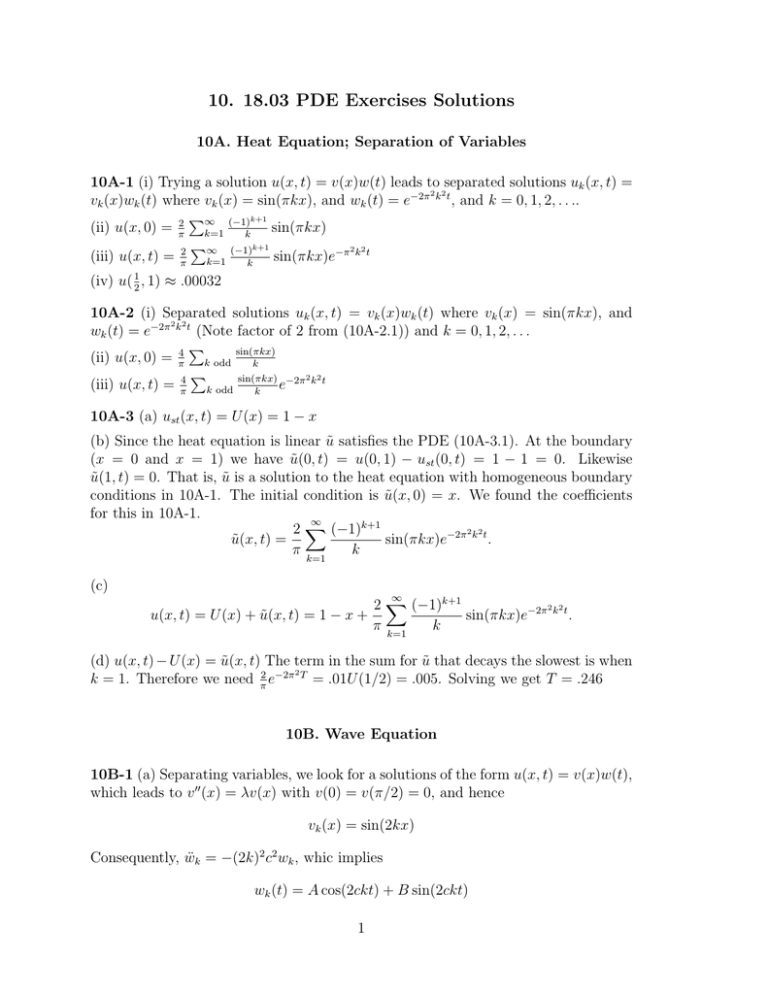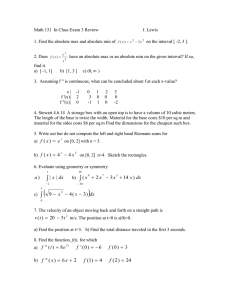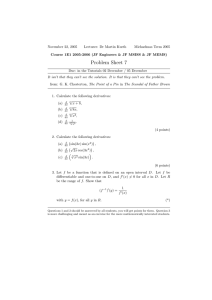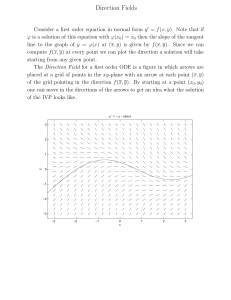10. 18.03 PDE Exercises Solutions
advertisement

10. 18.03 PDE Exercises Solutions 10A. Heat Equation; Separation of Variables 10A-1 (i) Trying a solution u(x, t) = v(x)w(t) leads to separated solutions uk (x, t) = 2 2 vk (x)wk (t) where vk (x) = sin(πkx), and wk (t) = e−2π k t , and k = 0, 1, 2, . . .. P (−1)k+1 (ii) u(x, 0) = π2 ∞ sin(πkx) k=1 k P k+1 2 2 (−1) sin(πkx)e−π k t (iii) u(x, t) = π2 ∞ k=1 k (iv) u( 12 , 1) ≈ .00032 10A-2 (i) Separated solutions uk (x, t) = vk (x)wk (t) where vk (x) = sin(πkx), and 2 2 wk (t) = e−2π k t (Note factor of 2 from (10A-2.1)) and k = 0, 1, 2, . . . P (ii) u(x, 0) = π4 k odd sin(πkx) k P sin(πkx) −2π 2 k2 t 4 (iii) u(x, t) = π k odd k e 10A-3 (a) ust (x, t) = U (x) = 1 − x (b) Since the heat equation is linear ũ satisfies the PDE (10A-3.1). At the boundary (x = 0 and x = 1) we have ũ(0, t) = u(0, 1) − ust (0, t) = 1 − 1 = 0. Likewise ũ(1, t) = 0. That is, ũ is a solution to the heat equation with homogeneous boundary conditions in 10A-1. The initial condition is ũ(x, 0) = x. We found the coefficients for this in 10A-1. ∞ 2 X (−1)k+1 2 2 sin(πkx)e−2π k t . ũ(x, t) = π k=1 k (c) ∞ 2 X (−1)k+1 2 2 u(x, t) = U (x) + ũ(x, t) = 1 − x + sin(πkx)e−2π k t . π k=1 k (d) u(x, t) − U (x) = ũ(x, t) The term in the sum for ũ that decays the slowest is when 2 k = 1. Therefore we need π2 e−2π T = .01U (1/2) = .005. Solving we get T = .246 10B. Wave Equation 10B-1 (a) Separating variables, we look for a solutions of the form u(x, t) = v(x)w(t), which leads to v 00 (x) = λv(x) with v(0) = v(π/2) = 0, and hence vk (x) = sin(2kx) Consequently, ẅk = −(2k)2 c2 wk , whic implies wk (t) = A cos(2ckt) + B sin(2ckt) 1 The normal modes are uk (x, t) = sin(2kx)(A cos(2ckt) + B sin(2ckt)), where A and B must be specified by an initial position and velocity of the string. 2c c (b) The main note (from the mode u1 ) has frequency = . You will also hear the 2π π ck higher harmonics at the frequencies , k = 2, 3, . . . . (The sound waves induced by π the vibrating string depend on the frequency in t of the modes.) (c) Longer strings have lower frequencies, lower notes, and shorter strings have higher frequencies, higher notes. If the length of the string is L, then the equations v 00 (x) = λv(x), v(0) = v(L) = 0 lead to solutions vk (x) = sin(kπx/L). (In part (a), L = π/2.) The associated angular frequencies in the t variable are kcπ/L, so the larger L, the smaller kcπ/L and the lower the note. Thus c is inversely proportional to the length of the string. (d) When you tighten the string, the notes get higher, and the frequency you hear is increased. (Tightening the string increases the tension in the string and increases the spring constant, which corresponds to c. The frequencies of the sounds are directly proportional to c.) 2 M.I.T. 18.03 Ordinary Differential Equations 18.03 Extra Notes and Exercises c Haynes Miller, David Jerison, Jennifer French and M.I.T., 2013 1




